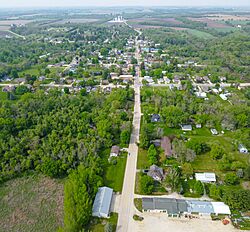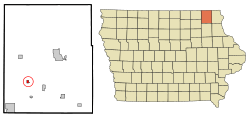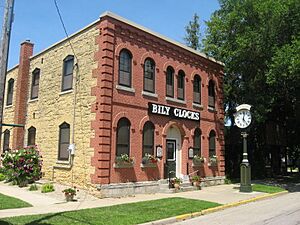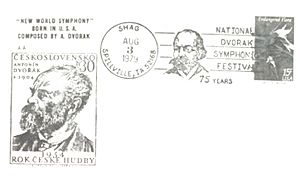Spillville, Iowa facts for kids
Quick facts for kids
Spillville, Iowa
|
|
|---|---|

Turkey River runs through town
|
|
| Nickname(s):
Spillville Fireworks
|
|

Location of Spillville, Iowa
|
|
| Country | |
| State | |
| County | Winneshiek |
| Area | |
| • Total | 0.45 sq mi (1.16 km2) |
| • Land | 0.44 sq mi (1.14 km2) |
| • Water | 0.01 sq mi (0.02 km2) |
| Elevation | 1,070 ft (326 m) |
| Population
(2020)
|
|
| • Total | 385 |
| • Density | 876.99/sq mi (338.41/km2) |
| Time zone | UTC-6 (Central (CST)) |
| • Summer (DST) | UTC-5 (CDT) |
| ZIP code |
52168
|
| Area code(s) | 563 |
| FIPS code | 19-74370 |
| GNIS feature ID | 0461848 |
Spillville is a small city in Winneshiek County, Iowa, United States. In 2020, about 385 people lived there. It's located in Calmar Township, a few miles west of Calmar and southwest of Decorah. Spillville is famous for its amazing Independence Day fireworks show, which happens on the first Saturday in July.
Contents
History of Spillville
Spillville was planned out in 1860 by a German man named Joseph Spielmann. The town was first called Spielville, after him. But someone misread the name, and it became Spillville!
Many people from Bohemia (now part of the Czech Republic), Germany, and Switzerland came to live here.
Musical History and Famous Visitors
Spillville has a rich history of music and culture. The famous Czech composer Antonín Dvořák spent much of 1893 in Spillville. He stayed with relatives of his friend, Josef Jan Kovařík. While in Spillville, Dvořák wrote some of his most important pieces. These include his huge Symphony No. 9 in E minor, also known as "From the New World." He also composed two famous chamber works: the String Quartet in F ("The American") and the String Quintet in E-flat.
Spillville is also home to the Inwood Ballroom, which opened in 1920. This ballroom was a popular spot for many famous musicians in the 20th century. Stars like Louis Armstrong, Glenn Miller, Guy Lombardo, and The Byrds all performed there.
Bily Clocks Museum and St. Wenceslaus Church
Many visitors to Spillville also go to the Bily Clocks Museum. This museum has a collection of amazing, detailed clocks made by two brothers, Frank and Joseph Bily. They created these clocks by hand between 1913 and 1958. The museum is in the same building where Dvořák lived when he was in Spillville.
The Roman Catholic church in Spillville, called St. Wenceslaus Church, was built in 1860. It is the oldest Czech Catholic church in the United States.
Geography of Spillville
Spillville is located at 43°12′N 91°57′W / 43.20°N 91.95°W.
The city covers about 0.43 square miles (1.11 square kilometers). Most of this area is land, with a very small part being water.
Population of Spillville
| Historical populations | ||
|---|---|---|
| Year | Pop. | ±% |
| 1880 | 340 | — |
| 1900 | 356 | +4.7% |
| 1910 | 320 | −10.1% |
| 1920 | 315 | −1.6% |
| 1930 | 304 | −3.5% |
| 1940 | 329 | +8.2% |
| 1950 | 363 | +10.3% |
| 1960 | 389 | +7.2% |
| 1970 | 361 | −7.2% |
| 1980 | 415 | +15.0% |
| 1990 | 387 | −6.7% |
| 2000 | 386 | −0.3% |
| 2010 | 367 | −4.9% |
| 2020 | 385 | +4.9% |
| Source: and Iowa Data Center Source: |
||
In 2020, there were 385 people living in Spillville. The city had 173 households. About 27.7% of these households had children under 18 living with them. The average age of people in Spillville was about 40 years old.
Parks and Recreation

- Riverside Park & the Inwood Pavilion: This park offers a place for outdoor activities. The Inwood Pavilion is part of this area.
Education in Spillville
Students in Spillville attend schools within the South Winneshiek Community School District.
There is also a Catholic school system called CFS Catholic School. It was formed by combining Catholic schools from Calmar, Festina, and Spillville. Before fall 2020, it had campuses in Calmar and Spillville. Now, the school has two main campuses: one in Ossian for grades K-2 and middle school, and one in Spillville for grades 3–4.
See also
 In Spanish: Spillville (Iowa) para niños
In Spanish: Spillville (Iowa) para niños



